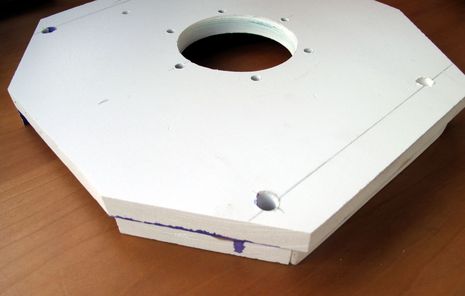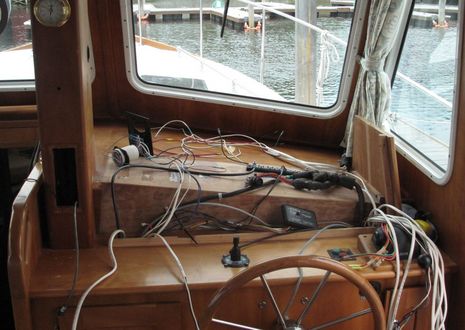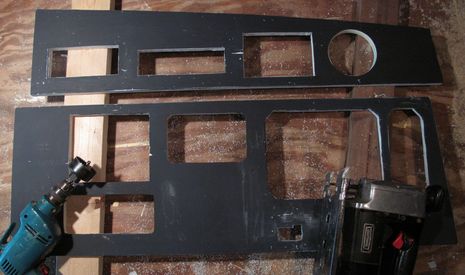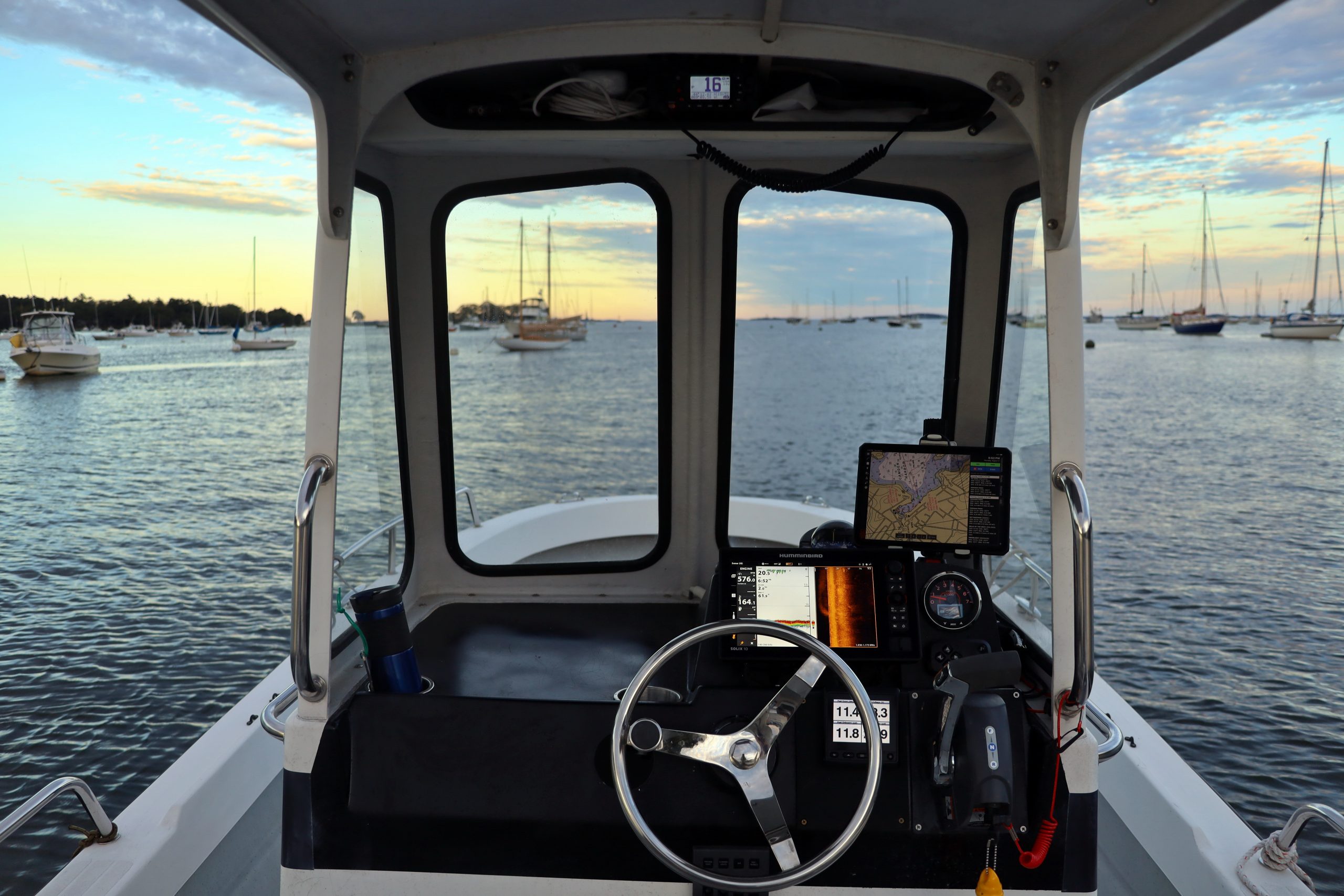Azek PVC board, great for electronics panels?
At first I was just going to replace the electronics panel at Gizmo’s lower helm, but I got carried away. And at this point I’ve got a boat that I can’t start — because the engine instruments, and much else, are disconnected — in a slip that I’m just bumming until the real occupant’s yacht is launched (which accounts for slow posting here). But the project is going well, and I’m particularly pleased with the Azek expanded PVC board product I’m experimenting with for the dash panel(s)…
Azek is not marketed for marine use, but I suspect it has many uses on boats. Compared to classic StarBoard solid polyethelene sheet, it’s lighter, stiffer, less expensive, and much easier to cut and shape with standard woodworking tools. (At least the latter also holds true for the traditional laminate and plywood panel that I’m replacing.) Azek also holds screws well, and you can weld pieces together with regular PVC plumbing glue. The only downsides I’ve seen so far is that it dents more easly than StarBoard or Formica — sort of like white pine — and the edges need to be hidden, both issues due to the fact that what’s between the mat skins is actually a very dense foam.
Of course where you don’t see it, Azek can be used as is and should remain stable despite any sort of weather. That’s what it’s all about. Below, for instance, is a temporary mount for the FLIR thermal camera I tested last season. I whipped it up quite quickly and it held up fine on Gizmo’s mast head. The new dash panels will hopefully look a lot more finished…

While Azek sheet stock only comes in white, it is supposed to take paint well, even dark colors, if you use the right “VinylSafe” latex. (You can find details about paint recommendations and sheet stock in the Azek “Paint” and “Product” PDFs here.) You can see in the photo below that I already knocked some paint off when I was cutting holes, but I didn’t let it dry long enough and it will be easy to re-coat anyway. You can also gather from the size of the PVC “dust” how easily this stuff cuts with a big toothed blade or hole saw. Rasp and sandpaper are also effective and fast. Gizmo may get more electronics updates than average boats, but I believe every electronics panel (and cable run) should be designed for change. Here’s what the lower helm used to look like, by the way, and note that I’m also building a new overhead radio and stereo panel. Plus expanding the gadget space behind this dash, and redoing the flying bridge set up to some yet undetermined extent; Gizmo is going to the next level! Please let me know if you’ve had any experience with Azek or similar plastics, or just how you like to build dash panels. But right now I better get back to work.















Note that I’m not having the problem with cuts melting shut behind my jigsaw blade, like I did with the Scanstrut Deck Pod. Azek is friendlier that way, plus I used 6tpi blade.
https://panbo.com/archives/2009/07/ray_c140w_deck_pod_install_a_dubbers_impressions_.html
We’ve had this product in place as outdoor decking and trim for more than eight years and are pleased. However, it attracts dirt like a magnet. A light breeze blowing across it builds a static charge, and that’s all she wrote. On the smooth surfaces it’s an easy clean. The faux wood grain, requires pressure washing to clean up (or more e-grease than I care to supply). Just a thought if you are using this for outside application.
Ben, do you know if formica or any type of plastic laminate could be glued to Azek? I have been looking for an alternative to starboard due to its weight vrs cost. I had been thinking of making some folding cocktail tables for use on deck.
Also does it gum up while cutting like starboard wood? Do you think it is strong enough to use as a dash panel with a helm attached to it?
Anyway it looks like Gizmo is coming along quite well. Can’t wait to see what new gadgets are going in the new dash panel. I hear you are coming to Seattle in September for the NMEA conference. I would like to extend an invitation to visit our little peice of paradise, Gedney Island or better known as Hat Island to the locals located in Northern Puget Sound. Just send me a PM.
Thanks,
Jeff
FYI:
Also Silver Salmon season will be at its peak at that time (September) also.
I’m not faliliar with this particular brand but I’ve been working with similar products like Sintra for years.
Almost all of the work I’ve done has been done using CNC router tables.
The product machines well, holds fasteners and with the right equipment can be bent and thermo-shaped.
I’ve used it on my old Catalina for instrument mounting, a fold-away cockpit table and for making a pedestal mounted accessory mounts.
Can’t speak to the long term UV stability of the product as we have sold that boat and moved on to a Grand Banks.
The only thing that was ever an issue for me was the static charge that the materrial often held which would cause it to attract dirt.
I have no relation to this company but this seemed like an opportune time to mention them. We needed to create an electronics panel for several devices (SSB, VHF, ST70 and a NASA Barometer) and wanted something sturdy.
I did a lot of research and found a company called Front Panel Express that will create custom panels for you out of aluminum or Perspex, and anodized in one of several colors (natural, black, red, green, gold, bronze, etc.). The really cool part is that they have an application you download – “Front Panel Designer”, that lets you create your panel in a CAD like environment. You can add knockouts (with corner radiuses, holes (threaded or unthreaded – you specify the thread), cavities, slots, engravings, etc.
When you are done, the software will give you a price estimate (they are very reasonable), and then you hit a button to submit your file for ordering. A week later, you get it in the mail.
Anyway, I just thought people might be interested as the software can also help you design a panel even if you don’t order it from them. You can mock it up, print it out at 100% scale, glue it to some backing and then test it out. I’d recommend ordering it from them though – the quality of our panel was excellent. It might be worth an entry too…
Their website is at http://www.frontpanelexpress.com/
I’m using expanded PVC foam board (1/8″ thickness) for my overhead liner. This stuff comes in many brands — Celtec and Sintra are the two that I’ve heard of — and it is used a lot (apparently) in the sign industry. I got 4′ x 8′ sheets from an industrial plastics supplier. I suspect it is a very similar material to the Azek stuff.
Just used Azek to mount a fish finder transducer on the transom of my aluminum skiff. Cut a 4×4 inch piece and glued it on the transom with 5200. Holes in the Azek – No holes in the transom. Painted with duckboat green Krylon Fusion made for pvc…
Hey Ben,
Maybe this is a little off-topic, but it looks as though you’ve installed a great distributed power system at your helm!
We’ve got a great designer position open if you’re available?
Best,
Rick Sorenson
Carling Technologies, Inc.
Moritz Aerospace, Inc.
Maretron LLC
I’m still a big fan of acrylics, you need a fabricator to make it for you, but the results are always professional looking in appearance. The costs for fabrication are moderate, and the materials are very durable, especially in indoors environment, although I have some on fly bridges that have held up well for many years. I don’t like Starboard for instrument panels, because getting a good edge finish (removing tool marks) is difficult, and tedious to do. I don’t like my panels to look like they have been chewed out by beavers. By back painting clear acrylic panels, you can get a huge array of color choices, but as I have said, “I let the owner pick the colors, so they are always right”. The material works okay in situ. A Rotozip works fine with a new blade, and sharp hole saws will cut without much melting. I have done several pieces on this subject. Bill Bishop
Thanks all, and particularly Chris with the link to Front Panel Express. The software seems fairly straight forward, pricing reasonable…might be just the thing to cover and make use of that old A/C controller cut out seen in the top photo on the wooden cable column. (Incidentally, if I ever fill that column, please shoot me. Also, Gizmo is down to one A/C unit now, part of my long term greening plan.)
Rick, “digital switching” is what I’m going for here, though “digital” in the urological sense!
Um, Ben, why are you doing this when the weather is nice? Time to be looking out the window and not at the instruments. We will be watching for the Gizmo AIS ping actually moving. -Doug
“Rick, “digital switching” is what I’m going for here, though “digital” in the urological sense!”
Hey Ben,
That might hurt!!!!
I’m intrigued by the posibility of heat forming this stuff. If it starts out at 5/4″ width there’s got to be a good amount left at the bottom of a vacuum mold.
I have been using black or white(inside/outside) ABS plastic,usually 1/4 inch on a plywood backing.
It is textured so it is not shiny and hides scrapes.
Easy to cut,cheap and available.
My house trim is AZEK. seems to be better then wood, holds paint very well and is easy to clean. Doesn’t expand or contract like starboard. Everything has its place, starboard is an excellent product but very expensive. not sutable for hatches or doors. to much movement in the heat. use low speed tools when cutting both products.
These folks have a neat on-line tool where you can design your panel, cut out’s for controls and all, and have the finished panel shipped to you.
http://www.frontpanelexpress.com/
On my sailboat their is an area for the engine controls with a clear plastic spalsh shield that includes a black Yanmar engine control panel. Using the designer I created a 2nd panel to sit next to the Yanmar panel, with matching finish, to hold some gauges.
I recently used 1/8″ PVC board with flat black mica laminated to it using high strength spray adhesive. I attached it to the dash of a 51′ bertram using contact cement. It Looked great for about 10 minutes, but once the sun and heat of a Miami, FL. Summer day hit the assembly the expansion and contraction rates were so different between materials(pvc and Mica) that it cupped big time. Needless to say I will not be doing it this way again. Starboard, aluminum, or acrylic for me in the future.
Thanks, Xavier. Sorry for what sounds like a bummer. I’m pretty pleased with the Azek for my lower helm, though the paint scratches a bit too easily. I haven’t done the upper helm yet, and it will rarely see Florida grade sun, but I’m optimistic that the special Sherwin Williams black paint I’m using can take the heat. It’s supposed to.
Ben,
Where have you been purchasing Azek in sheet sizes?
Thanks,
John Hinckley
John, I ordered a 4′ x 8′ sheet of 1/2″ Azek from my local hardware/lumber store, Rankin’s. It cost about $130 and took about a week to deliver, and I imagine most any place like Rankins can source it, because most stock Azek trim stock.
I’m pretty happy with the results. The flying bridge panel didn’t warp in the sun as some thought it might. The special VinylSafe flat black paint is a little too easy to scratch and chip, but it’s also easy to touch up.
I realize this is an old thread…
Is there an edge sealing product useful for treating exposed edges of Azek, after routing a profile, for example? I realize the cut edges are not porous, but they are also not pretty either.
Also, regarding laminating formica to many substrates, including Azek, it’s always a good idea to do both sides to gain warpage resistance. I believe that was the real problem, and not the Florida sun mentioned in another comment.
Hi Karl, The Azek edges will take the paint I described in the entry but they definitely don’t look as good as the smooth panel surface. I have not had any trouble with panel warpage but then again all the panels have fairly heavy electronics fastened in.
Overall I remain a fan of Azek and similar products for fast inexpensive (but not fancy) boat work. I just put that camera mount seen above back to work on Gizmo’s masthead along with similar boarding I bought at Lowe’s for antenna spreaders. Custom built aluminum would be better but this works.
By the way, I briefly tried to remove the Azek spacers I’d glued to the camera mount but it was impossible. Azek and PVC glue are forever!
That’s pretty interesting. Do you think it might also hold a sandable putty on the edges? How about a routered edge?